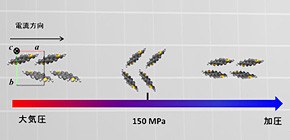
Anomalous pressure dependent conductivity in organic transistors has been revealed
Under the leadership of SAKAI Ken-ichi , Researcher and TAKEYA Jun-ichi , Professor, Institute of Scientific and Industrial Research, Osaka University and FUJIWARA Akihiko , Chief Fellow, Japan Synchrotron Radiation Research Institute (JASRI), a group of researchers discovered a gigantic and anomalous pressure effect in electrical conduction of organic transistors and succeeded in clarifying its mechanism.
In typical organic transistors, soft organic single crystals are placed on hard inorganic substrates (SiO2) resulting in organic single crystals being broken because of differences in shrinkage percentages when the device is shrunk by compressing. In order to cope with this problem, this group made all parts of the device from polymeric materials with a shrinkage percentage similar to that of organic substances and tested the possibility of unified shrinkage of the device. As a result, the group succeeded in creating organic transistors capable to operate under pressure of 1GPa or higher and assessed electrical conductivity under high pressure.
Furthermore, in order to assess high-pressure property of organic transistors, this group also studied sulfur atoms in DNTT molecules, clarifying the two effects: "extremely large pressure effect" by sudden activation of intermolecular electron transfer and "negative pressure effect" by molecular rotation.
This group's achievement will promote research in higher pressure effects and chemical pressure effects as well as the application to pressure sensors.
Abstract
Anomalous pressure dependent conductivity is revealed for heteroacene organic field-effect transistors of dinaphtho[2, 3-b:2′, 3′-f]thieno[3, 2-b]thiophene single crystals in the direction of a and b crystallographic axes. In contrast to the normal characteristics of a monotonic increase in mobility μ with the application of external hydrostatic pressure P in conductors, we found that the present organic semiconductor devices exhibit nonmonotonic and gigantic pressure dependence including an even negative pressure coefficient dμ/dP. In combination with a structural analysis based on x-ray diffraction experiments under pressure, it is suggested that on-site molecular orientation and displacement peculiar in heteroacene molecules are responsible for the anomalous pressure effect.

Figure 1

Figure 2
To learn more about this research, please read the full research report entitled " Anomalous Pressure Effect in Heteroacene Organic Field-Effect Transistors " at this page of the Physical Review Letters website.
Related links :
